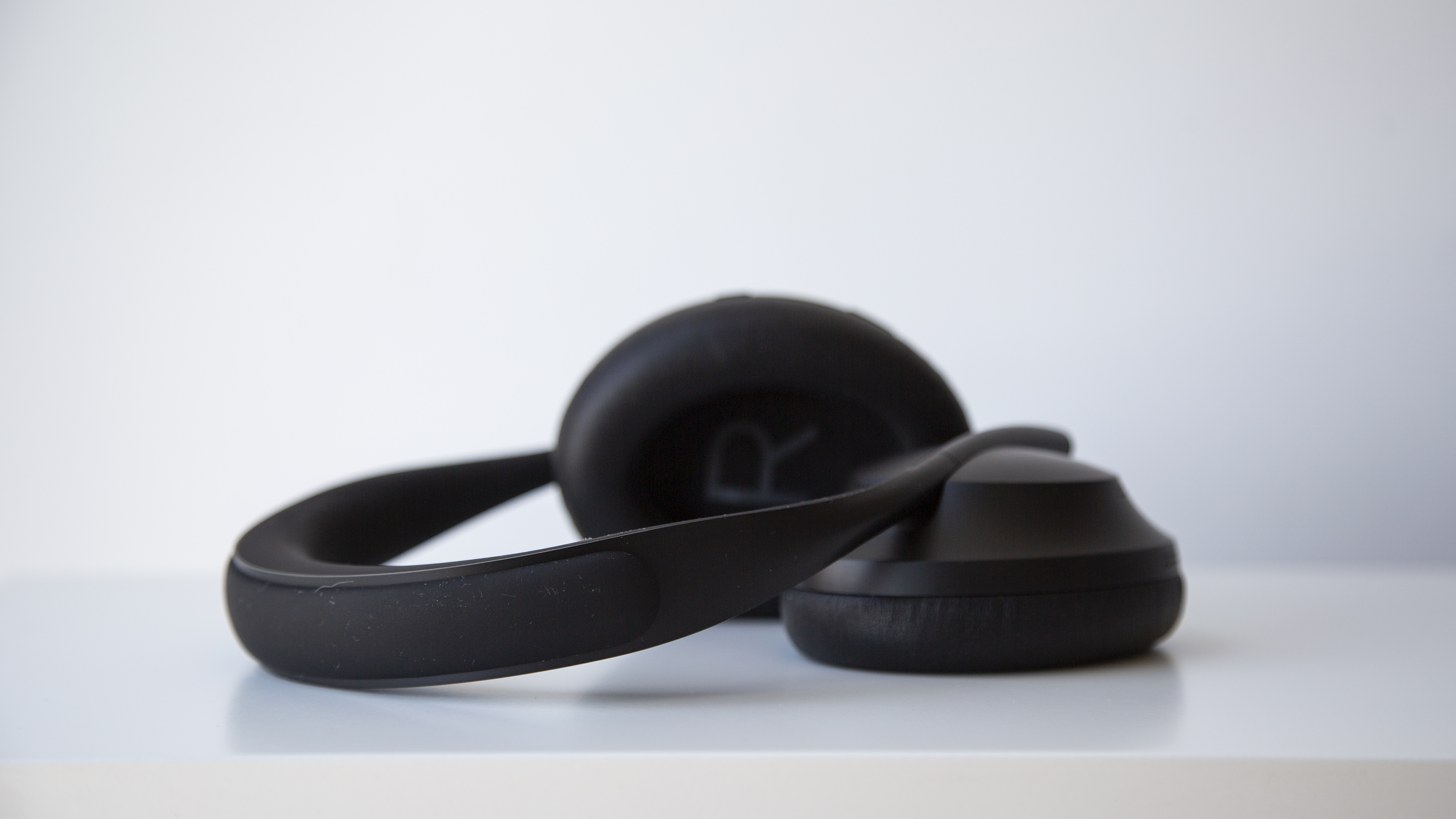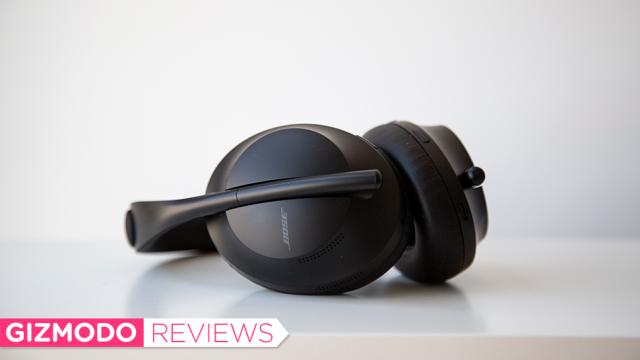Bose just released an important update to its popular line of wireless noise-cancelling headphones. They are different. They’re weirdly stylish. Most importantly, they’re good. Also expensive.
The Bose Noise Cancelling Headphone 700 cost $US400 ($571), and they’re the heir apparent to the Bose Quiet Comfort 35 II headset, which sells for $359.
Editor’s Note: While the Bose Noise Cancelling Headphone 700 doesn’t have official pricing yet, there is an online pre-order listing on a third party website which prices it at $684.99.
The most noticeable difference between the two is the design. The new 700s feature a headband that wraps around the whole setup, connecting the ear cups with a single piece of nice-seeming plastic. This means the ear cups can swivel to either side and that the whole situation feels more refined than the awkward dad design of the Quiet Comfort headphones. The new headphones look almost edgy.

Bose Noise Cancelling Headphones 700
What is it?
Smart noise-cancelling headphones
Cost
$US400 ($571)
Like
Terrific noise-cancelling, super comfortable
No like
Uninspired sound quality
The real improvement comes in the guts, however. Bose says its new 700 headphones build on the QuietComfort noise-cancelling technology and use six microphones to drown out the din of the world around you. The marque upgrade to these headphones involves a pair of microphones that work with another pair to create a beamforming array that captures the sound of your voice better than other Bose headphones. This should mean that your friend can hear you better on phone calls and that your voice assistant commands come through loud and clear. The 700s also feature Bluetooth 5.0 connectivity and conveniently connect to two devices at once.
I’ve spent a week with the new Bose headphones and am honestly surprised to report that the noise-cancelling microphones actually work really well. The Bose 700 headphones actually do clean up the background noise when you’re talking into the microphone. I tested them against the Bose QuietComfort 35 II and the Sony WH-M1000XM3, Bose’s biggest competitor in the noise-cancelling headphone space and the difference in clarity with the Bose 700s is undeniable.
The actual audio quality of the voices it picks up, unfortunately, is still not great. While the Bose 700 headphones do an admirable job isolating your voice in a noisy environment, the actual quality of that audio in any situation is not markedly better than competitors. But still, the fact that your friends will hear you better when you’re calling from, say, a Major League Baseball game is a big deal.
As far as cancelling noise while listening, the Bose 700s are remarkable. They’re better than the QuietComfort 35 II headphones, and in a head-to-head test, the new Bose held their own against the excellent Sony 1000XM3 headset. While I’m tempted to say that Sony’s noise-cancelling prowess is still slightly stronger, the showdown was really too close to call. That means after two years of Sony dominating the noise-cancelling headphone industry, Bose is back with hell of a new competitor.
There are a lot of other reasons to like the new Bose noise-cancelling headphones. Like I already said, the sleek design is a welcome update to the humdrum look of older models, and the new uni-band design is super comfortable. The Bose 700 headphones are very light at 254 grams — which also happens to be the weight of their competitor, the Sony WH-1000XM3—and the earcups are also nice and roomy.
Meanwhile, the updated user interface is refreshing. Gone is the QuietComfort 35 II‘s awkward switch on the ear cup. Instead, there’s a single power button that also handles Bluetooth pairing on the right ear cup. Beneath that is another button that you use to summon a voice assistant. (Amazon Alexa and Google Assistant are currently available — no word about Siri compatibility.)
The left ear cup has another button that controls the level of noise-cancelling. (There are three: off, half blast, and full blast.) There are also some touch controls on the right ear cup that let you play and pause your track as well as adjust the volume. This didn’t work great for me all the time, but I’ve made the same complaint about the touch controls on Sony’s headphones. My big complaint, however, is that the Bose 700s do not fold, which means you’d better love using the (large) included case or risking the headphones getting bent up in your bag while travelling.
The sound quality on the Bose 700s is also worth talking about. It’s good! It’s also specifically Bose. If you’re an armchair audiophile, you might know what I mean by this. Bose headphones (and speakers) have a recognisable sound, one that not everyone loves. The Bose sound is very approachable, with a lot of emphasis on vocals and the upper range but limited bass response.
In my opinion, certain types of music sound uninspired through Bose-branded drivers. The Bose 700s are no different. I really like the way “Volare” by the Gipsy Kings and “Stayin’ Alive” by the Bee Gees sound. Those songs don’t have a lot of bass. “Higher Love” by Kygo and Whitney Houston sounds boring, which is too bad because it’s a tremendously energetic track. And by contrast, it sounds tremendously energetic through the Sony 1000XM3.
My main criticism of the Bose 700s, then, is both subjective and essential. I don’t like the way they sound, and they do have a very specific sound. I prefer the way that their Sony competitors sound, and even more importantly, Sony gives me better control over tuning the headphones to suit my tastes.
Bose is notorious for offering minimal equaliser control, and the Bose 700s are no exception. Right now there’s no equaliser control at all, but the company says it will be available through the Bose Music app later this year. There’s a chance the options to adjust might be limited to three points—bass, mids, treble — as they are with some other products that use the Bose Music app, although we won’t know for sure until the app update gets pushed out. By contrast, Sony offers five points of equaliser control as well as some options for changing the position of the sound through its app.
Speaking of the Bose Music app, there’s one additional feature in it that you might love or laugh at. It’s called Bose AR, and as the name implies, it offers an audio augmented reality element to other apps. If the phrase “audio augmented reality” doesn’t make immediate sense to you, that’s understandable.
It’s basically something that Bose invented and first released with its Frames sunglasses-slash-headphones. Think of it like an audio layer that can be applied to various experiences, from touring a city to going on a run to sitting in your chair.
The Bose Music app directs you to partner apps that use Bose AR technology in combination with your phone’s GPS chip or the headphones’ accelerometers. The most useful one is called NaviGuide and it basically pumps step-by-step directions into your headphones as you’re trying to get where you’re going.
Google Maps does this, too, but NaviGuide adds a layer of fun by giving you details on points of interest along your route based on which way your head is pointing. So if you’re walking through New York City, and looking towards the Empire State Building, the app might be like, “That’s the Empire State Building.” I imagine this experience is cooler in exotic locations, where you might not notice neat stuff.
The other Bose AR apps I tried seemed a bit dumb. There’s one called Audiojack that offers “audio movies,” which basically seem like movie sound effects that require you to use your imagination to feel like you’re having an adventure. There’s an audio tour app called Otocast, and a fitness coach app called By Pear for Bose. At the end of the day, though, it doesn’t matter if these Bose AR experience seem useless because you don’t have to use them.
What matters most is that using the Bose 700s as noise-cancelling headphones is a pleasure. Bose claims that the headphones get 20 hours of battery life, which proved true, but it’s also far less than the 36 hours offered by the Jabra Elite 85h noise-cancelling headphones. You’ll probably never forget to charge the new Bose headset, though, because a friendly robot voice tells you how many hours of juice you have left every time you turn the unit on.
So, although the Bose Noise Cancelling Headphone 700 represent a huge leap forward from older Bose headphones, I can’t quite say they’re the best in every regard. They are the best for phone calls, and that’s a big deal. They’re a formidable competitor to the Sony 1000XM3 in terms of noise cancelling.
They’re comfortable, attractive, and easy to use. They don’t fold though, and they’re not my favourite-sounding headphones. It’s a bummer there’s not much you can do to tune them to your own preferences. Yet the new Bose 700s are great headphones. As they should be for the price.
README
-
Huge improvement over Bose’s old QuietComfort 35 II noise-cancelling headphones
-
Noise-cancelling is practically as good as Sony’s excellent WH-1000XM3
-
Sound quality is not as enjoyable as the Sony Headphones
-
Do not fold, so not the best for travel
